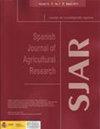Effect of dietary vegetable lipid sources on the growth performance and whole-body fatty acid profile of giant trahira, Hoplias lacerdae
IF 0.8
4区 农林科学
Q3 AGRICULTURE, MULTIDISCIPLINARY
引用次数: 0
Abstract
Aim of study: To evaluate which vegetable lipid source promotes better growth performance, whole-body composition and fatty acid profile for juvenile giant trahira (Hoplias lacerdae). Area of study: Fish Nutrition Laboratory of the University of Viçosa (UFV), MG, Brazil. Material and methods: A 50-day feed trial with four treatments, consisting of diets containing different vegetable lipid sources (canola, linseed, soybean or olive oil), was conducted with juveniles of 4.76 ± 0.50 cm and 1.97 ± 0.20 g. Main results: There were no effects of vegetable lipid sources on growth performance. Fish fed diets containing canola oil had higher body lipid deposition and fish fed with linseed oil had lower body lipid content (up to -19.29%) than fish from other treatments. Fish fed canola oil showed lower proportions of saturated fatty acids (up to -11.27%) in the body. Fish fed diets containing soybean oil and linseed oil showed the highest percentages of linoleic and α-linolenic fatty acids, respectively. Fish fed diets containing soybean and linseed oils also had higher total polyunsaturated fatty acids content (up to +81.14%). Fish fed diets containing linseed oil had lower content of monounsaturated fatty acids (up to -58.59%) and higher content of docosahexaenoic (up to +175%) and eicosapentaenoic (not detectable to detectable) acids. Research highlights: Juveniles of giant thraira can alter the whole-body fatty acid profile due to their ability to desaturate and elongate the n3 and n6 series fatty acids. Linseed oil was identified as lipid source for this fish species.饲粮植物脂源对大鲵生长性能及全身脂肪酸谱的影响
研究目的:评价哪种植物脂质来源能促进巨斑蝶幼鱼更好的生长性能、全身组成和脂肪酸组成。研究领域:维索萨大学鱼类营养实验室,MG,巴西。材料和方法:对4.76±0.50cm和1.97±0.20g的幼鱼进行了为期50天的饲料试验,共有四个处理,包括含有不同植物油脂来源(油菜籽、亚麻籽、大豆或橄榄油)的日粮。主要结果:植物油脂来源对生长性能没有影响。与其他处理的鱼相比,喂食含有菜籽油的鱼具有更高的体脂沉积,而喂食亚麻籽油的鱼具有更低的体脂含量(高达-19.29%)。食用菜籽油的鱼体内饱和脂肪酸比例较低(高达-11.27%)。含有大豆油和亚麻籽油的鱼饲料中亚油酸和α-亚麻酸的百分比分别最高。含有大豆油和亚麻籽油的鱼饲料的总多不饱和脂肪酸含量也较高(高达+814%)。含有亚麻籽油的鱼类饲料的单不饱和脂肪酸类含量较低(高达-58.59%),二十二碳六烯酸(高达+175%)和二十碳五烯酸(检测不到)含量较高。研究重点:巨大梭子鱼的幼崽可以改变全身脂肪酸的分布,因为它们能够去饱和和延长n3和n6系列脂肪酸。亚麻籽油被鉴定为该鱼类的脂质来源。
本文章由计算机程序翻译,如有差异,请以英文原文为准。
求助全文
约1分钟内获得全文
求助全文
来源期刊

Spanish Journal of Agricultural Research
农林科学-农业综合
CiteScore
2.00
自引率
0.00%
发文量
60
审稿时长
6 months
期刊介绍:
The Spanish Journal of Agricultural Research (SJAR) is a quarterly international journal that accepts research articles, reviews and short communications of content related to agriculture. Research articles and short communications must report original work not previously published in any language and not under consideration for publication elsewhere.
The main aim of SJAR is to publish papers that report research findings on the following topics: agricultural economics; agricultural engineering; agricultural environment and ecology; animal breeding, genetics and reproduction; animal health and welfare; animal production; plant breeding, genetics and genetic resources; plant physiology; plant production (field and horticultural crops); plant protection; soil science; and water management.
 求助内容:
求助内容: 应助结果提醒方式:
应助结果提醒方式:


